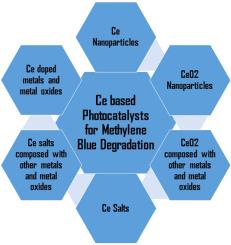用于亚甲基蓝降解的含铈光催化剂最新文献综述
IF 5.4
Q2 ENGINEERING, ENVIRONMENTAL
引用次数: 0
摘要
亚甲基蓝被用于纺织、医疗诊断和外科手术等多个领域,随着时间的推移,其在全球废水中的浓度正在显著增加,对人类和其他生物体的健康造成了极大的危害。世界范围内正在开展研究,采用吸附、光解、光催化降解、光电催化降解和消除等多种方法消除亚甲基蓝和其他相关污染物。利用光催化降解或光解技术可以很好地降解和消除废水中的亚甲蓝。一些半导体纳米材料正被用于降解废水中的亚甲基蓝和其他相关药物。本文是针对 2024 年初发表的有关含铈催化剂光降解亚甲基蓝的研究论文进行的综述。这些研究采用了多种反应条件,包括辐射类型(紫外线、太阳能和可见光)、溶液的 pH 值、亚甲基蓝的浓度、所用纳米材料的浓度以及其他添加剂和活化剂(如 H2O2)对光降解效率的影响。铈在这些光催化剂中以不同的形式使用:氧化物形式、与其他金属氧化物或金属混合的氧化物、含铈盐的纳米材料,或作为其他氧化物或其他金属的掺杂剂。与铈一起使用的金属包括锌、锡、碲、镁、钼、铁、钛、铝、镍、铜和锰。报告的文献摘要以表格形式列出了所用催化剂的类型、反应条件和降解效率。还讨论了不同参数对铈基催化剂光催化性能的比较和相对影响。此外,还介绍了一些早期发表的评论文章。本文章由计算机程序翻译,如有差异,请以英文原文为准。

Recent literature review of Cerium-containing photocatalysts used for methylene blue degradation
Methylene blue is being used in several applications including textile, medical diagnostics, and surgical procedures, and its concentration in wastewater is increasing significantly globally with time, posing high health hazards for humans and other living organisms. Research studies are in progress worldwide to eliminate methylene blue and other related pollutants using several methods, including adsorption, photolysis, photocatalytic degradation, and photoelectrocatalytic degradation and elimination. Methylene blue can be degraded and eliminated proficiently from wastewater using photocatalytic degradation or photolysis. Several semiconductor nanomaterials are being utilized to degrade methylene blue and other related drugs in wastewater. This is a review conducted for the research papers published in early 2024 on cerium-containing catalysts for the photodegradation of methylene blue. These studies have used a variety of reaction conditions that include radiation types (UV, solar, and visible), pH of the solution, concentration of methylene blue, concentration of nanomaterials used, and presence of other additives and activators such as H2O2 on the photodegradation efficiency. The cerium has been used in these photocatalysts in different forms; oxide forms, oxides mixed with other metal oxides or metals, cerium salt containing nanomaterials, or as a dopant to other oxides or other metals. The metals used with cerium include zinc, tin, tellurium, magnesium, molybdenum, iron, titanium, aluminum, nickel, copper, and manganese. A summary of the reported literature showing the type of catalysts used, reaction conditions, and degradation efficiency has been presented in tabulated form. A discussion is made on the comparative and relative effects of different parameters on the photocatalytic performance of cerium-based catalysts. Some of the earlier published reviews are also presented.
求助全文
通过发布文献求助,成功后即可免费获取论文全文。
去求助
来源期刊

Journal of hazardous materials advances
Environmental Engineering
CiteScore
4.80
自引率
0.00%
发文量
0
审稿时长
50 days
 求助内容:
求助内容: 应助结果提醒方式:
应助结果提醒方式:


